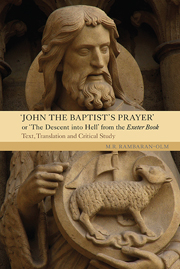 John the Baptist's Prayer 'The Descent into Hell' from the Exeter Book
John the Baptist's Prayer 'The Descent into Hell' from the Exeter Book Book contents
- Frontmatter
- Contents
- Illustrations
- Acknowledgements
- Abbreviations
- Dedication
- Introduction
- 1 Palaeography, Codicology and Language
- 2 The Descensus Motif
- 3 Literary Analysis
- 4 Selected Comparative Studies and Analogous Literature
- Afterword
- Text and Translation
- Commentary
- Appendix 1 The Doctrine of the Descensus according to Post-Apostolic and Medieval Commentators from the First Century to the End of the Eleventh Century
- Appendix 2 Scriptural References
- Appendix 3 Other Sources and Analogues
- Appendix 4 Transcription and Images of fol. 120r
- Glossary
- Biblioigraphy
- Index
2 - The Descensus Motif
Published online by Cambridge University Press: 05 August 2014
- Frontmatter
- Contents
- Illustrations
- Acknowledgements
- Abbreviations
- Dedication
- Introduction
- 1 Palaeography, Codicology and Language
- 2 The Descensus Motif
- 3 Literary Analysis
- 4 Selected Comparative Studies and Analogous Literature
- Afterword
- Text and Translation
- Commentary
- Appendix 1 The Doctrine of the Descensus according to Post-Apostolic and Medieval Commentators from the First Century to the End of the Eleventh Century
- Appendix 2 Scriptural References
- Appendix 3 Other Sources and Analogues
- Appendix 4 Transcription and Images of fol. 120r
- Glossary
- Biblioigraphy
- Index
Summary
The concept of Christ's Descent into the Underworld was moulded into the framework of Christian teaching and thought early in ecclesiastical history. Although the doctrine of the descensus seems to have always been a complicated concept, it can be said that by the Anglo-Saxon period the descensus had not only secured its position into Christian doctrine, but had etched its way into the popular imagination, commonly depicted in art, poetry, sermons and even drama. A brief analysis of the origins of this belief will aid our understanding of its significance in popular Anglo-Saxon consciousness.
WHERE DID THE IDEA OF THE DESCENSUS ORIGINATE?
Although many scholars and theologians claim that there is very little evidence in the Bible regarding the descensus, there are a number of allusions scattered throughout scripture, and one interpretation in particular which has emerged with probability as a direct reference to the descensus. In his epistle to the Ephesians, St Paul writes:
Unicuique autem nostrum data est gratia secundum mensuram donationis Christi. Propter quod dicit ascendens in altum captivam duxit captivitatem dedit dona hominibus. Quod autem ascendit quid est nisi quia et descendit primum in inferiores partes terrae. Qui descendit ipse est et qui ascendit super omnes caelos ut impleret omnia. Et ipse dedit quosdam quidem apostolos quosdam autem prophetas alios vero evangelistas alios autem pastores et doctores.
- Type
- Chapter
- Information
- John the Baptist's Prayer 'The Descent into Hell' from the Exeter BookText, Translation and Critical Study, pp. 31 - 52Publisher: Boydell & BrewerPrint publication year: 2014
